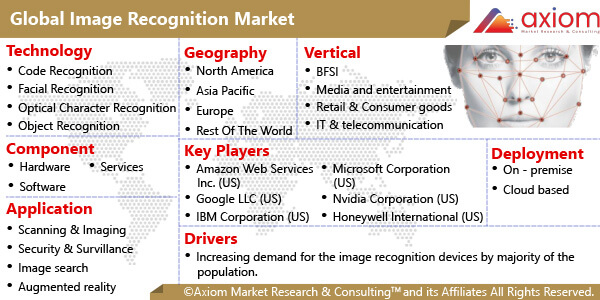Image recognition, is the ability of software to identify objects, places, people, buildings, and several other variables as digital images. A digital image is an image composed of picture elements, also known as pixels. So, the computer machine sees an image as numerical values of pixels; and in order to recognise any image, the computer has to recognise the patterns and regularities in the numerical data.
Image recognition technique has emerged as one of the promising technology for identifying individuals, in the recent past. Consumers are increasingly demanding a variety of image recognition applications and technologies in mobile computing devices and gaming consoles.
Image Recognition Market Dynamics
The image recognition market is highly driven by the growing demand for the image recognition applications in automotive and public safety sectors. Also, the rise in the usability of artificial intelligence by huge number of companies at across the globe is acting as one of the important factor for the market of image recognition technology.
COVID 19 Impact on Image Recognition Market
The globally spread COVID-19 has changed the dynamic of many countries and their working cultures. However, the market of various technologies is almost not affected by the spread of the virus or the lockdown restrictions. While, on the contrary, it is a matter of fact that the global image recognition technology market was very much utilised even during the time of pandemic. The reason, accounting to the demand of mobile applications or software applications that could work without the sense of touch.
For example, there was a huge demand for the mobile applications that could sense the COVID symptomatic patients, if present around at a corresponding distance.
Image Recognition Market Segmental Overview
The report analyses the image recognition market based on technology, component, application, deployment, vertical, and geography. On the basis of technology, it is segregated into code recognition, facial recognition, optical character recognition, object recognition, and pattern recognition. Based upon the components, the image recognition market is further segregated into hardware, software and services. On the basis of the applications, the market is further divided into scanning & imaging, security & surveillance, image search, augmented reality, and marketing. By the type of deployment, the market is divided into on premise and cloud based categories.
Image Recognition Market by Technology
Based on the type of technology, the image recognition market is segmented into code recognition, facial recognition, optical character recognition, object recognition, and pattern recognition.
The code recognition technology helps to recognize the codes containing information when interacted with smart devices, example, QR codes. Whereas, the facial recognition technology helps to recognize the facial features, recently used for the locking systems of smart devices.
Image Recognition Market by Component
Based on the components type, the image recognition market is segmented into hardware, software, and services. On the basis of service component, the market is further segmented into implementation services, consulting & training, and support & maintenance services.
Image Recognition Market by Application
In the terms of application, the image recognition market has been divided into scanning & imaging, security & surveillance, image search, augmented reality, and marketing. The increase in the public safety concerns drives the growth of the market in the security & surveillance segment. Also, the technological segment is known to be growing at a preferential rate, owing to the reason of latest technology implications, which require the image recognitions as the trending requirements.
Image Recognition Market by Deployment
Based on the deployment, the market is segregated into on premise and cloud based. Due to the high demand of cloud based applications, the cloud based segment of the image recognition market is known to have a preferential growth as compared to the on premise segment.
Image Recognition Market by Vertical
A huge number of companies around various verticals, such as media and entertainment, retail & consumer goods, it & telecommunication, healthcare, transportation & logistics, are increasingly making the use of digital image processing. As far as the media & entertainment vertical is concerned, the digital image processing currently is finding a huge scope due to the trends of social networking sites.
Image Recognition Market by Geography
Geographically, the image recognition market is studied across the countries of key regions such as, North America, Europe, Asia Pacific and rest of the world regions which includes Latin America, and Middle East &Africa.
The presence of varied number of technical companies in the Asia Pacific region makes it one of the dominating regions in the image recognition market. Also, the region of North America accounts for the significant share of the market, due to the increasing number of electronic gadgets and smart phone users in that region.
Image Recognition Market Key Players
Some of the major players operating in this market include Amazon Web Services Inc. (US), Google LLC (US), IBM Corporation (US), Microsoft Corporation (US), Nvidia Corporation (US), Honeywell International (US), Hitachi Ltd. (Japan), LTU Technologies (France), Catchoom Technologies (Spain), Blippar Ltd. (England), Slyce (Canada), among many others.











